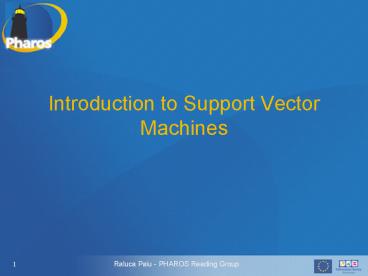Introduction to Support Vector Machines - PowerPoint PPT Presentation
1 / 18
Title:
Introduction to Support Vector Machines
Description:
Raluca Paiu - PHAROS Reading Group. 1. Introduction to Support Vector Machines ... Raluca Paiu - PHAROS Reading Group. 4. SVMs - Generalization. Data is ... – PowerPoint PPT presentation
Number of Views:80
Avg rating:3.0/5.0
Title: Introduction to Support Vector Machines
1
Introduction to Support Vector Machines
2
SVMs - Usage
- SVMs set of supervised learning methods
- Classification
- Handwritten digit recognition
- Object recognition
- Speaker identification
- Face detection in images
- Text categorization
- Regression
- Curve fitting
- Forecasting
3
SVMs Basic Idea
- Data classification
- E.g. data represented as points in R2
- Can we find a 1 - dimensional line that separates
them? - Constraint we want to find
the line that maximizes
the
separation (margin) between
the 2 classes of points.
4
SVMs - Generalization
- Data is represented as vectors in Rn
- Build a (n-1) dimensional hyperplane separating
the data - Two parallel hyperplanes created on each side of
this hyperplane. - Find the hyperplane that maximizes the distance
between the two parallel hyperplanes
5
SVMs Formalization 1
- Points (x1, c1), (x2, c2), , (xn, cn)
- xi n dimensional vectors (of scaled values
usually 0, 1 or -1, 1) - ci constant -1, 1
- The separating hyperplane
- w x - b 0
- Problem find w and b
6
SVMs Formalization 2
- xi w - b 1, for ci 1 (1)
- xi w - b -1, for ci -1 (2)
- Distance between planes
- 2 / w
- Goal maximize (2 / w) ? minimize w
7
SVMs Formalization 3
- From eq. (1) and (2)
- ci (xi w b) 1, 1 i n
- Primal Form
- minimize (1/2) w2, subject to ci (xi w b)
1
8
SVMs Formalization 4
- minimize LP
- ai 0
- For computing b, solve
- and take the mean value for b
9
SVMs Formalization 5
- Dual Form (based on KKT conditions)
- maximize LD
- ai 0
- All points in the training set for which ai 0
are called support vectors - The optimization problem is sometimes simpler
- Constraints for this version are simpler than the
original constraints
10
The Non-Separable Case 1
- Soft Margin Method
- choose a hyperplane that splits the examples
as cleanly as possible, while still maximizing
the distance to the nearest cleanly split
examples. - ci (xi w b) 1 - ?i, 1 i n
- ?i 0
- The error should be as small as possible
11
The Non-Separable Case 2
- Minimize
- (1/2) w2 C ??i, such that
- ci (xi w b) 1 - ?i, 1 i n
12
Linear SVMs Overview
- The classifier is a separating hyperplane.
- Most important training points are support
vectors they define the hyperplane. - Quadratic optimization algorithms can identify
which training points xi are support vectors with
non-zero Lagrangian multipliers ai. - Both in the dual formulation of the problem and
in the solution training points appear only
inside dot products
Find a1aN such that Q(a) Sai - ½SSaiajci cj xi
xj is maximized and (1) Saici 0 (2) 0 ai
C for all ai
f(x) Saicixix b
13
Non-linear SVMs
- Datasets that are linearly separable with some
noise work out great - But what are we going to do if the dataset is
just too hard? - How about mapping data to a higher-dimensional
space
0
x
14
Non-linear Classification
- create non-linear classifiers by applying the
kernel-trick - the resulting algorithm is similar, just that
- all dot products (xixj) are replaced by
non-linear kernel functions
15
Kernel Trick 1
- Instead of the inner product ltxi, xjgt use a
non-linear function K(xi, xj) ? - the boundary between the classes is
- K(x,w) b 0 ()
- K(xi, xj) F(xi)F(xj)
- F Rd -gt H
- The set of points x ? Rd on the boundary ()
becomes a curved surface
16
Kernel Trick 2
- A kernel function is some function that
corresponds to an inner product in some expanded
feature space. - For some functions K(xi,xj) checking that
- K(xi,xj) f(xi) f(xj) can be
cumbersome. - Mercers theorem
- Every semi-positive definite symmetric function
is a kernel
17
Kernel Trick 3
- Common Kernel functions
- Polynomial (homogeneous)
- Polynomial (inhomogeneous)
- Radial Basis function
, ? gt 0 - Gaussian Radial basis function
- Sigmoid
- for some (not every) ? gt 0 and c lt 0
18
Multi-Class Classification
- SVMs can only handle two-class outputs (i.e. a
categorical output variable with arity 2). - What can be done?
- Answer with output arity N, learn N SVMs
- SVM 1 learns Output1 vs Output ! 1
- SVM 2 learns Output2 vs Output ! 2
- SVM n learns Outputn vs Output ! n
- Then to predict the output for a new input, just
predict with each SVM and find out which one puts
the prediction the furthest into the positive
region.































